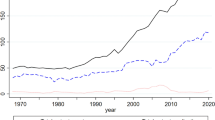Abstract
The paper analyses the asymmetric volatility of patents related to pollution prevention and abatement (hereafter, anti-pollution) technologies registered in the USA. Ecological and pollution prevention technology patents have increased steadily over time, with the 1990's having been a period of intensive patenting of technologies related to the environment. The time-varying nature of the volatility of anti-pollution technology patents registered in the USA is examined using monthly data from the US Patent and Trademark Office for the period January 1975 to December 1999. Alternative symmetric and asymmetric volatility models, such as GARCH, GJR and EGARCH, are estimated and tested against each other using full sample and rolling windows estimation.
Similar content being viewed by others
References
Berndt, E. K., B. H. Hall, R. E. Hall, J. A. Hausman (1974), Estimation and inference in nonlinear structural models, Annals of Economic and Social Measurement, 3: 653-665.
Boussama, F. (2000), Asymptotic normality for the quasi-maximum likelihood estimator of a GARCH model, Comptes Rendus de l'Académie des Sciences, Série I, 331: 81-84.
Bollerslev, T. (1986), Generalized autoregressive conditional heteroskedasticity, Journal of Econometrics, 31: 307-327.
Bollerslev, T., J. M. Wooldridge (1992), Quasi-maximum likelihood estimation and inference in dynamic models with time-varying covariances, Econometric Reviews, 11: 143-173.
Dunn, S., J. A. Peterson (Eds) (2001), Hydrogen Futures: Towards a Sustainable Energy System, Worldwatch Institute, Washington DC.
Elie, L., T. Jeantheau (1995), Consistency in heteroskedastic models, Comptes Rendus de l'Académie des Sciences, Série I, 320: 1255-1258.
Engle, R. F. (1982), Autoregressive conditional heteroskedasticity with estimates of the variance of United Kingdom inflation, Econometrica, 50: 987-1007.
Glosten, L., R. Jagannathan, D. Runkle (1992), On the relation between the expected value and volatility of nominal excess returns on stocks, Journal of Finance, 46: 1779-1801.
Jeantheau, T. (1998), Strong consistency of estimators for multivariate ARCH models, Econometric Theory, 14: 70-86.
Ling, S., W. K. Li (1997), On fractionally integrated autoregressive moving-average models with conditional heteroskedasticity, Journal of the American Statistical Association, 92: 1184-1194.
Ling, S., M. McAleer (2000), Testing GARCH versus E-GARCH, In: W.-S. Chan, W. K. Li, H. Tong (Eds), Statistics and Finance: An Interface, Imperial College Press, London, pp. 226-242.
Ling, S., M. McAleer (2002a), Necessary and sufficient moment conditions for the GARCH(r,s) and asymmetric power GARCH(r,s) models, Econometric Theory, 18: 722-729.
Ling, S., M. McAleer (2002b), Stationarity and the existence of moments of a family of GARCH processes, Journal of Econometrics, 106: 109-117.
Ling, S., M. McAleer (2003), Asymptotic theory for a vector ARMA-GARCH model, Econometric Theory, 19: 278-308.
Marinova, D., M. McAleer (2003a), Nanotechnology strength indicators: International rankings based on US Patents, Nanotechnology, 14: R1-R7.
Marinova, D., M. McAleer (2003b), Modelling trends and volatility in ecological patents in the USA, Environmental Modelling and Software, 18(3): 195-203.
McAleer, M., F. Chan, D. Marinova (to appear), An econometric analysis of asymmetric volatility: Theory and application to patents, paper presented to the Australasian Meeting of the Econometric Society, Brisbane, July 2002, Journal of Econometrics.
Nelson, D. B. (1991), Conditional heteroskedasticity in asset returns: A new approach, Econometrica, 59: 347-370.
Phillips, P. C. B., P. Perron (1988), Testing for a unit root in time series regression, Biometrika, 75(2):335-346.
Shephard, N. (1996), Statistical aspects of ARCH and stochastic volatility, In: O. E. Barndorff-Nielsen, D. R. Cox, D. V. Hinkley (Eds), Statistical Models in Econometrics, Finance and Other Fields, Chapman & Hall, London, pp. 1-67.
World Bank (2001), Making Sustainable Commitments: An Environment Strategy for the World Bank, Washington DC.
Author information
Authors and Affiliations
Rights and permissions
About this article
Cite this article
Chan, F., Marinova, D. & McAleer, M. Modelling the asymmetric volatility of anti-pollution patents in the USA. Scientometrics 59, 179–197 (2004). https://doi.org/10.1023/B:SCIE.0000018527.22276.10
Issue Date:
DOI: https://doi.org/10.1023/B:SCIE.0000018527.22276.10




